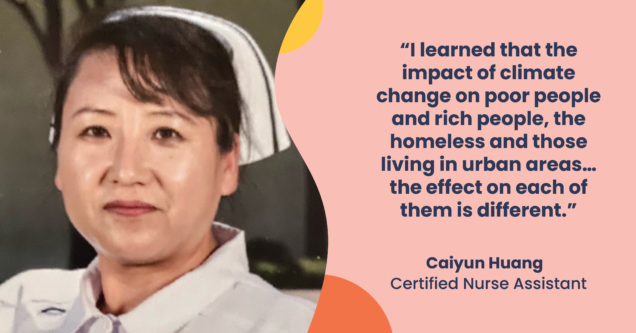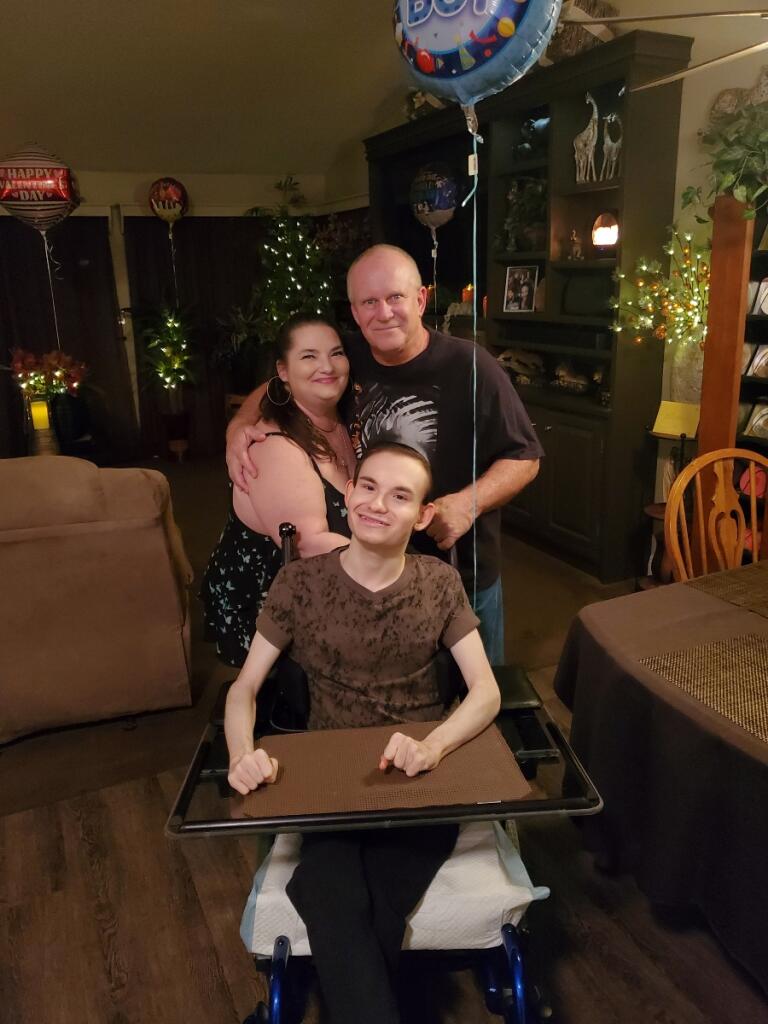In a way, it’s a song Tammie Becker sings every day. From the day her son Michael was born and fast forward 22 years later, the song has been fine-tuned to the same rhythm and routine. This is life caring for someone you love who has cerebral palsy. Wake up. Check on Michael. Bend down to kiss him. Dress him. Change his diaper. Blend his food just right. Lift him in and out of his wheelchair. Give him his meds. Feed him his meals. Help him back to his bed. Start over the next day.
This song is a love song, Tammie says. But that sameness can cut. “It’s important for things not to change, but it’s like a broken record. It’s hard to do it every day for 20+ years, over and over and over again.”
Caregiving takes a lot of love and patience, of which Tammie never runs out.
Tammie is one of the more than 100,000 parents caring for their children as an In-Home Supportive Services (IHSS) provider in California. Recently, Tammie completed caregiver training from the Center for Caregiver Advancement (CCA), joining the more than 11,000 IHSS providers that CCA has trained in the past 10 years. The training is offered in six languages and designed for adults with varying levels of education. It’s earned high marks for improving care, reducing emergency department visits and hospital stays. It’s also given caregivers the tools to deal with isolation, loneliness, and depression.
“I didn’t expect to actually get what I got out of it,” she said. “I knew this (training) would be very important and useful as I always want to be a better caregiver for my son. That’s why I decided to do it. I was so pleased after I took the training class. It was so rewarding”
Tammie said one of the most useful lessons included body mechanics.
“Learning the correct ways of lifting and doing things so you don’t hurt yourself, this training was awesome,” she said, as it really hit home for her and her husband, David. “These past 20+ years of lifting our son Michael have really affected our backs, arms, and hands. You don’t realize just how much your body is affected from all the years of wear and tear.”
Tammie and her husband have been working as a team since Michael was born two and a half months too early due to a pregnancy complication. Michael had a bleed on both sides of his brain and, later, was diagnosed with cerebral palsy. He requires full-time care.
“We have to do pretty much everything for him,” Tammie said. “It’s like taking care of an infant.”
Caregivers learn CPR, techniques on dressing and undressing their consumers, changing their position every 15 minutes, planning nutritious meals, and the “five rights” of giving medication: the right patient, the right drug, the right dose, the right route, and the right time.
“We’re more aware now of the medication that he does take, as he needs it each month, checking the labels, making sure I’m giving him the proper medication, and it’s called in when it needs to be called in,” Tammie said. “You think you know everything but there’s so much more to learn! I’m so happy and grateful (CCA has) these wonderful training classes for us to take and learn from. They are so worth it and fun, too. It was such a great experience and I encourage everyone to take the training course.”
For the length of the training, the caregivers formed a community of comrades. Tammie said most caregivers can speak with their consumers, and get feedback, but since Michael is nonverbal, routine is their language.
Caregiving during the pandemic: “Hopefully one day things will get better and safer”
The COVID pandemic shut the three of them out of the world. Tammie was worried that her son might not take to remote learning, “but he did, he recognized his teacher and he actually paid full attention. He was so cute and did a great job with virtual home teaching.” Now that things are loosening up, they are still very careful about being out in public. Michael can’t wear a mask so in-person activities have not been an option.
“Hopefully one day things will get better and safer, and there will be special daycare programs with Regional Center that will open up,” Tammie said. “He loves being around other kids and benefits from one-on-one special/fun programs. Until then, we’ll do the best we can at home.”
Michael is now a high school graduate, an achievement his mother cherishes. “I’ve always been the type of person that never treated my son like he has a disability. I was like, he’s normal in every way, if not more than most people and even though I knew he had challenges and special needs, I always felt that way,” she said.
“We are so proud of Michael and all his accomplishments. It’s been a very long journey to get to this point, lots of mountains to climb. We don’t look at what he can’t do, we look at every single thing he can. We are so blessed and love him dearly.”
Life as a caregiver: “…they have feelings, and … they matter”
What does Tammie wish people knew about life as a caregiver? That’s a big question, this mother said.
“To (know) that they have feelings, and that they matter,” she said. “Life as a caregiver has its moments, I’m not gonna lie, it’s very hard work and it’s not going to be easy. Every single day is a challenge but you have to be just full of love, compassion, patience and respect. And, always communicate.”
If anything, Tammie said even though she’s constantly teaching Michael so many different things every single day, she said Michael is also teaching her things in return. When Tammie said she feels weary of the weight of her daily duties and responsibilities, she always picks herself up, puts a smile on her face, and prevails. Even though her son doesn’t have the words to let her know she is doing a good job, she knows he’s happy and well taken care of, and she knows he loves her in his own way.
The most rewarding part of her day is when she is done with her role as a caregiver and she can simply be Michael’s mom.
“Then I can actually relax and spend time with him and giggle and be silly, and you know, watch cartoons with him. We call it family time where we all just come together. I have a huge bed in our master bedroom and we all just kind of plop on it. And you know, it feels so good to be together and not have any (medical) tasks. That’s what’s most rewarding for me, knowing I can take a deep breath and be with my family…my handsome son and amazing husband, and let’s not forget our sweet cat, Rocky! And enjoy that to its fullest.”














